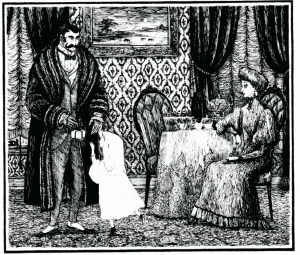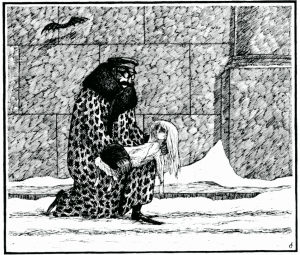Gorey’s Hapless Child was so striking to me after we read it in class today that I’ve been thinking of it since. After going back to it for the second time, I noticed many things I didn’t see the first time. For example, the little girl appears in the pristine white dress in the first pictures, almost glowing with happiness. Then at the school she’s clothed in black but returns to a white gown after her escape. However, it is not the same whiteness–it slowly dirties and grays as the story progresses, to the ultimate tattered state it’s in when she’s run over. This is very symbolic of the little girl’s own mental and physical condition. Her father, too, comes back starkly different from when he first appears.
Physically, he remains the same large, muscled man. He’s still in clothed in furs, although the one in which he returns in boasts a much more ostentatious patterning. What I noticed, however, were his large goggles covering his eyes.
It could just be part of his outfit as a driver to keep it consistent with the story but it’s interesting to consider the idea that it may be symbolic of him, having gone abroad and returned with all these riches, become blind to his family. Even when he’s holding his little girl there is no recognition she is his daughter and for me, this is what makes the ending most tragic of all. It breaks the most fundamental relationship between a parent and child, making an already depressing ending utterly heartbreaking.



Erica,
This story also stood out to me the most from the ones we read aloud today (and not in a good way). I kept waiting for the plot to be resolved but it only got worse. I like your observation of Charlotte Sophia’s dress coloring and how you relate it to her physical and mental condition. I think that the dress observation can also be applied to her father’s wardrobe. His uniform is all white, reflecting his strong physical state and emotional confidence (illustrated by the three medals on his chest upon his return).
I think the whiteness could also represent purity or innocence. The dress gets dirtier as Charlotte Sophia is abused more and more and the father takes off his uniform and exchanges it for a darker robe when he realizes he needs to search for his daughter.
I also think it is interesting that this is one of the few Gorey pieces in this book where both the pictures and text align so closely. I wonder if the combination of appropriate text and illustrations made the story more powerful. I would think so.
When the little girl broke free of her captor, I thought that her life was going to turn around for the better. The sadness I felt from this story was due not only to the fact that the father ended up killing his child, but also because the father didn’t even recognize the girl as his child. It is also interesting to note that just as the dress the girl is wearing becomes more dirty throughout the story, the shading around her eyes becomes darker at well. This shading hints at the emotional pain that the girl goes through, as well as the physical pain.